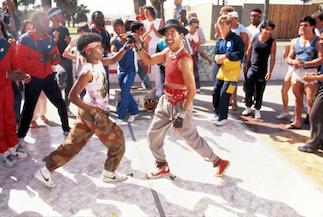The Number One Movie in America: Breakin'
By Sean Collier
June 28, 2020
The old aphorism is straightforward: “Strike while the iron is hot.” This is an established truism in Hollywood, particularly as concerns sequels; if you’ve got a hit that could shoulder another chapter, you should be in pre-production by the time the audience digests their popcorn. The sooner you can capitalize on warm feelings, the less likely it is the crowds will move on.
This is a reliable formula; many sequels have flopped by virtue of coming out far too late. Yet in the case of the 1984 breakdancing hit “Breakin’,” the iron may have been ... too hot?
It’s an inelegant metaphor at this point, so let’s press on.
“Breakin’,” a clunky yet lovable appropriation of early hip-hop culture, was an instant hit after its May 4, 1984 release. It won that weekend with more than $6 million, holding off the debuting “Sixteen Candles” for the top spot. It went on to earn $38.6 million and became the 18th highest-grossing film of a year stacked with blockbusters.
The production company behind “Breakin’,” the former Cannon Group, was exiting a lucrative distribution deal with MGM and eager to capitalize on the film’s success. After what must’ve been a remarkably rushed production process, a sequel — “Breakin’ 2: Electric Boogaloo” — was released Christmas weekend of the same year.
I didn’t believe it at first either, but yes: Both “Breakin’” and “Breakin’ 2” are 1984 releases. And the first one didn’t come out until May.
That wasn’t even the end of the whirlwind franchise, as the little-remembered third chapter, “Rappin’,” was released on May 10, 1985, less than six months after “Breakin’ 2.” Did this breakneck pace work for Cannon and the breakdancing franchise?
Not even a little bit.
“Breakin’ 2” was mildly profitable, but debuted in 10th place among a crowded holiday marketplace; it earned $15.1 million total, well under half of its predecessor’s total. “Rappin’” only managed to stay in theaters for a few weeks, pulling in less than $2 million.
As much as the original film was a hit and a cultural moment — and it certainly was, with kids from coast to coast attempting to imitate the moves of series stars Adolfo "Shabba Doo" Quiñones and Michael "Boogaloo Shrimp" Chambers — the novelty wore off almost immediately, especially in terms of mainstream box office.
The original film is more useful as a cultural artifact than as a standalone film. The main plot is grating (and, unsurprisingly, focused exclusively on the film’s white characters), as traditional dancer Kelly (Lucinda Dickey) livens up her moves by forming a crew with breakdancers Ozone (Quiñones) and Turbo (Chambers). The story is kind of about her fight to get the stuffy Los Angeles dance community to take breakdancing seriously — but it’s mostly about every straight, male character pursuing her romantically.
When Turbo and Ozone are left alone to dance (which happens far too infrequently), “Breakin’” comes alive. Oddly, the problem here is not enough dancing; if some of the extraneous scenes (like a bizarre brawl at a country bar) and Kelly-focused developments were excised in favor of more unadorned dance scenes, “Breakin’” would’ve been better than it turned out to be.
And “Breakin’ 2” might have actually made some money.
“Breakin’” is the subject of the latest episode of The Number One Movie in America, a look back at past box-office champions. Each episode’s film is drawn at random from a list of every number-one movie since 1982. Please listen and subscribe!
Next time: It gets the job done, sure, but is it magnificent?




